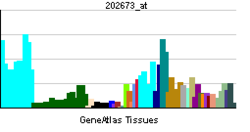- DPM1
-
Dolichol-phosphate mannosyltransferase is an enzyme that in humans is encoded by the DPM1 gene.[1][2][3]
Dolichol-phosphate mannose (Dol-P-Man) serves as a donor of mannosyl residues on the lumenal side of the endoplasmic reticulum (ER). Lack of Dol-P-Man results in defective surface expression of GPI-anchored proteins. Dol-P-Man is synthesized from GDP-mannose and dolichol-phosphate on the cytosolic side of the ER by the enzyme dolichyl-phosphate mannosyltransferase. Human DPM1 lacks a carboxy-terminal transmembrane domain and signal sequence and is regulated by DPM2.[3]
References
- ^ Colussi PA, Taron CH, Mack JC, Orlean P (Aug 1997). "Human and Saccharomyces cerevisiae dolichol phosphate mannose synthases represent two classes of the enzyme, but both function in Schizosaccharomyces pombe". Proc Natl Acad Sci U S A 94 (15): 7873–8. doi:10.1073/pnas.94.15.7873. PMC 21522. PMID 9223280. http://www.pubmedcentral.nih.gov/articlerender.fcgi?tool=pmcentrez&artid=21522.
- ^ Tomita S, Inoue N, Maeda Y, Ohishi K, Takeda J, Kinoshita T (May 1998). "A homologue of Saccharomyces cerevisiae Dpm1p is not sufficient for synthesis of dolichol-phosphate-mannose in mammalian cells". J Biol Chem 273 (15): 9249–54. doi:10.1074/jbc.273.15.9249. PMID 9535917.
- ^ a b "Entrez Gene: DPM1 dolichyl-phosphate mannosyltransferase polypeptide 1, catalytic subunit". http://www.ncbi.nlm.nih.gov/sites/entrez?Db=gene&Cmd=ShowDetailView&TermToSearch=8813.
Further reading
- Maeda Y, Tomita S, Watanabe R, et al. (1998). "DPM2 regulates biosynthesis of dolichol phosphate-mannose in mammalian cells: correct subcellular localization and stabilization of DPM1, and binding of dolichol phosphate". EMBO J. 17 (17): 4920–9. doi:10.1093/emboj/17.17.4920. PMC 1170821. PMID 9724629. http://www.pubmedcentral.nih.gov/articlerender.fcgi?tool=pmcentrez&artid=1170821.
- Kim S, Westphal V, Srikrishna G, et al. (2000). "Dolichol phosphate mannose synthase (DPM1) mutations define congenital disorder of glycosylation Ie (CDG-Ie)". J. Clin. Invest. 105 (2): 191–8. doi:10.1172/JCI7302. PMC 377427. PMID 10642597. http://www.pubmedcentral.nih.gov/articlerender.fcgi?tool=pmcentrez&artid=377427.
- Imbach T, Schenk B, Schollen E, et al. (2000). "Deficiency of dolichol-phosphate-mannose synthase-1 causes congenital disorder of glycosylation type Ie". J. Clin. Invest. 105 (2): 233–9. doi:10.1172/JCI8691. PMC 377434. PMID 10642602. http://www.pubmedcentral.nih.gov/articlerender.fcgi?tool=pmcentrez&artid=377434.
- Maeda Y, Tanaka S, Hino J, et al. (2000). "Human dolichol-phosphate-mannose synthase consists of three subunits, DPM1, DPM2 and DPM3". EMBO J. 19 (11): 2475–82. doi:10.1093/emboj/19.11.2475. PMC 212771. PMID 10835346. http://www.pubmedcentral.nih.gov/articlerender.fcgi?tool=pmcentrez&artid=212771.
- Deloukas P, Matthews LH, Ashurst J, et al. (2002). "The DNA sequence and comparative analysis of human chromosome 20". Nature 414 (6866): 865–71. doi:10.1038/414865a. PMID 11780052.
- Strausberg RL, Feingold EA, Grouse LH, et al. (2003). "Generation and initial analysis of more than 15,000 full-length human and mouse cDNA sequences". Proc. Natl. Acad. Sci. U.S.A. 99 (26): 16899–903. doi:10.1073/pnas.242603899. PMC 139241. PMID 12477932. http://www.pubmedcentral.nih.gov/articlerender.fcgi?tool=pmcentrez&artid=139241.
- Gerhard DS, Wagner L, Feingold EA, et al. (2004). "The Status, Quality, and Expansion of the NIH Full-Length cDNA Project: The Mammalian Gene Collection (MGC)". Genome Res. 14 (10B): 2121–7. doi:10.1101/gr.2596504. PMC 528928. PMID 15489334. http://www.pubmedcentral.nih.gov/articlerender.fcgi?tool=pmcentrez&artid=528928.
- García-Silva MT, Matthijs G, Schollen E, et al. (2005). "Congenital disorder of glycosylation (CDG) type Ie. A new patient". J. Inherit. Metab. Dis. 27 (5): 591–600. doi:10.1023/B:BOLI.0000042984.42433.d8. PMID 15669674.
- Ashida H, Maeda Y, Kinoshita T (2006). "DPM1, the catalytic subunit of dolichol-phosphate mannose synthase, is tethered to and stabilized on the endoplasmic reticulum membrane by DPM3". J. Biol. Chem. 281 (2): 896–904. doi:10.1074/jbc.M511311200. PMID 16280320.
- Olsen JV, Blagoev B, Gnad F, et al. (2006). "Global, in vivo, and site-specific phosphorylation dynamics in signaling networks". Cell 127 (3): 635–48. doi:10.1016/j.cell.2006.09.026. PMID 17081983.
- Ewing RM, Chu P, Elisma F, et al. (2007). "Large-scale mapping of human protein–protein interactions by mass spectrometry". Mol. Syst. Biol. 3 (1): 89. doi:10.1038/msb4100134. PMC 1847948. PMID 17353931. http://www.pubmedcentral.nih.gov/articlerender.fcgi?tool=pmcentrez&artid=1847948.
External links
Transferases: glycosyltransferases (EC 2.4) 2.4.1: Hexosyl-
transferases2.4.2: Pentosyl-
transferasesOtherOther2.4.99: Sialyl
transferasesCategories:- Human proteins
- Chromosome 20 gene stubs
Wikimedia Foundation. 2010.

